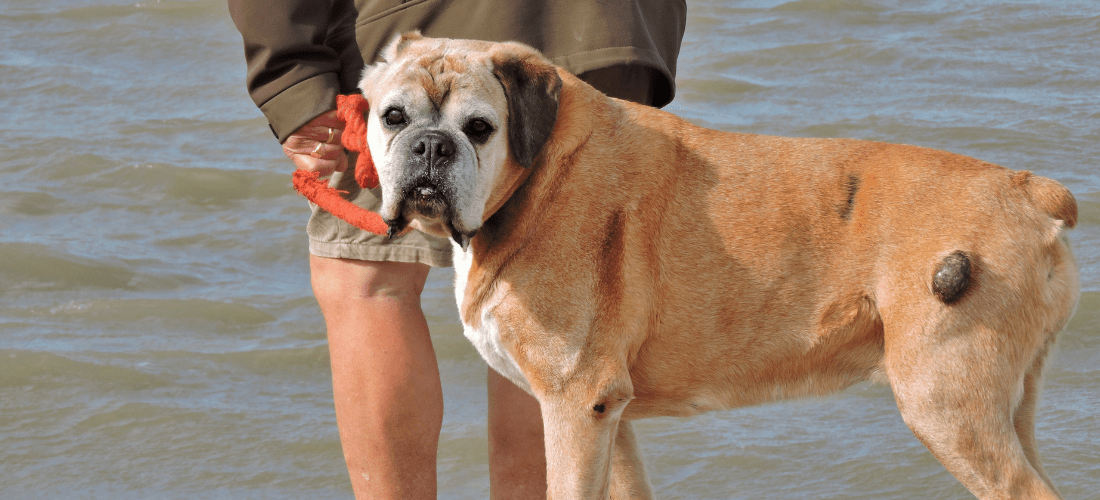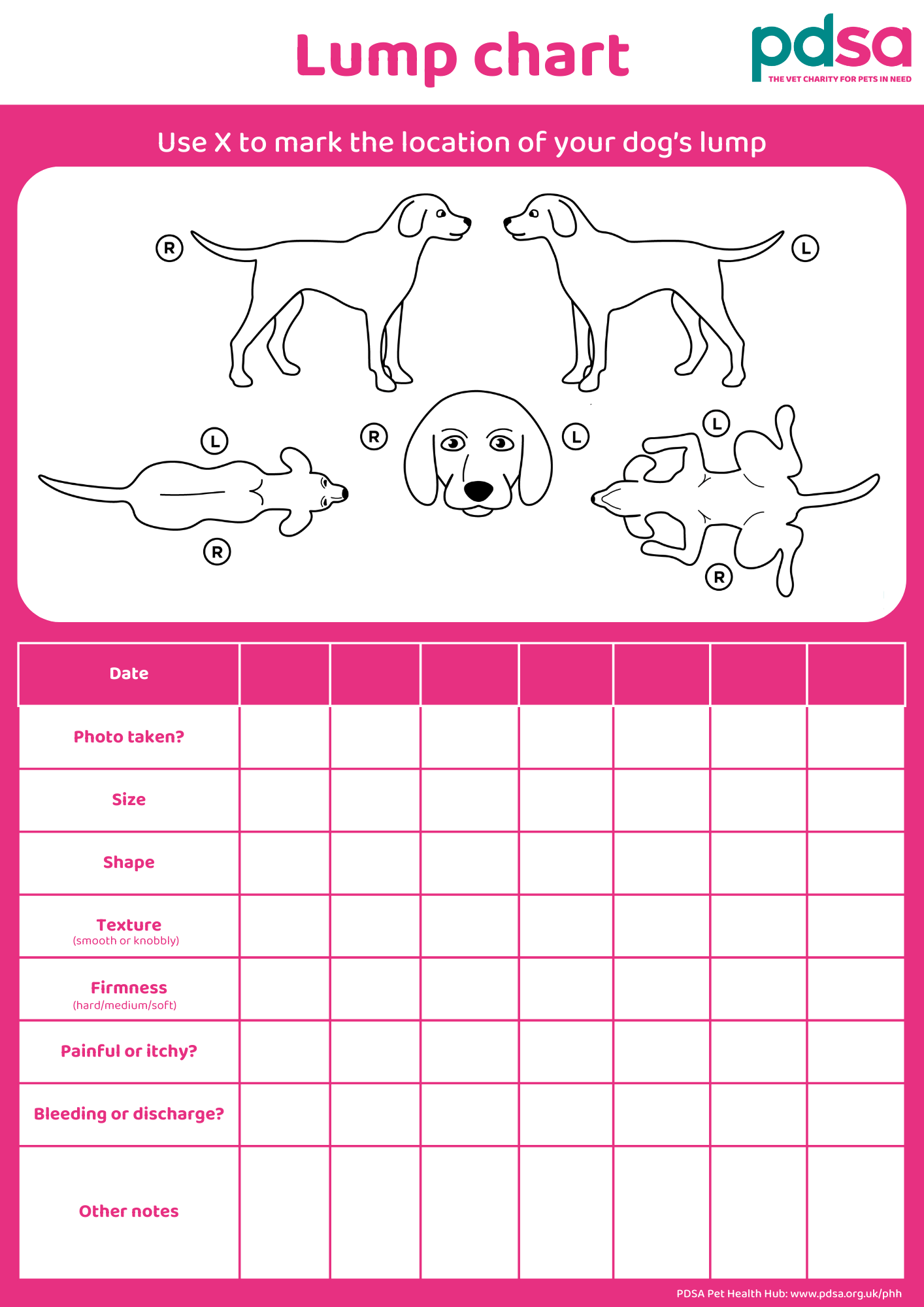Skin lumps and tumours in dogs
Overview
- Lumps are common in dogs. Most aren’t cancerous, but it's important to have any new ones checked by your vet.
- Causes: Lumps can be caused by variety of things such as infections, warts, cysts, non-cancerous tumours, and cancerous tumours.
- Diagnosis: Your vet will examine your dog’s lump and may recommend taking a sample of it for testing.
- Treatment: The treatment needed for a lump depends entirely on its type and location.

The location and appearance of a lump can give important clues about what it is. Some can be diagnosed by examination but most need further testing. This can be done by:
- Fine Needle Aspirate (FNA): A sample of cells are taken from the lump using a small needle and syringe. This is usually possible during a consultation and without anaesthetic, though some pets may need a sedative to keep them safe and still while the needle is inserted.
- Biopsy: A larger sample of the lump is taken under anaesthetic or sedation. Biopsies can be used for lumps that are difficult to sample by FNA, or where FNA results haven’t given a clear diagnosis.
Once the sample has been analysed your vet will be able to recommend the best next steps.
Common skin lumps in dogs
It’s important to remember that not all skin lumps are cancerous. Some of the most common causes of skin lumps in dogs include:
Abscesses
An abscess is a painful collection of pus under the skin. Abscesses tend to be hot, red, very tender, and can also cause symptoms of illness such as high temperature and lethargy (low energy). Abscesses are usually caused by a bacterial infection developing as a result of a wound such as a bite, insect sting, or after surgery. If you suspect your dog has an abscess, contact your vet for an appointment.
Enlarged lymph nodes
Lymph nodes are small, bean-shaped glands that are part of the body’s immune system. They help filter out harmful substances and fight infection. Lymph nodes are located throughout the body and often become enlarged when the body is responding to an illness or infection. If you notice enlarged lymph nodes on your dog, it's important to contact your vet for advice. While one or two enlarged lymph nodes tend to indicate a minor infection, several enlarged lymph nodes in multiple areas of the body can sometimes be a sign of a more serious condition, such as cancer.
Skin cysts
A skin cyst is a round, fluid-filled lump that develops in the skin. Cysts often develop due to a blockage in a hair follicle or skin gland and can be filled with thin liquid or a thick creamy substance. While most cysts are harmless and require no treatment, some can become inflamed, infected, or painful. In these cases, your vet may recommend removal. It’s important to avoid squeezing or puncturing cysts as this can increase the risk of infection and inflammation.
Ticks
Ticks are parasites that feed on animal and human blood and are very common in dogs. Once they've attached and started feeding, they can grow to the size of a small pea and are often mistaken for lumps or skin tags. Never try and pull the tick off without a specialised ‘tick remover’, as part of the tick can become detached and remain in the skin causing infection and pain. Find out more about ticks on dogs.
Insect bites
Insect bites are common in dogs and often cause a swelling/lump, redness and itching. Insect bite reactions tend to be short-lived and usually resolve without treatment. In the rare circumstance that your dog develops a more severe reaction to an insect bite, and shows symptoms such as difficulty breathing, severe swelling, collapse, vomiting or diarrhoea, contact your vet immediately. Read more about Insect bites and stings in dogs.
Injection site reactions
An injection site reaction is a swelling that occurs at the site of an injection. Injection site reactions are relatively common and don’t tend to be painful or cause illness. However, it’s important to let your vet know if your dog develops an injection site reaction that doesn’t resolve within a couple of weeks, starts to get bigger, is bothering them or seems painful. Fortunately, most injection site reactions resolve by themselves without treatment.
Haematomas
A haematoma is a swelling filled with blood that’s usually caused by a knock or injury. Haematomas can also be caused by clotting problems but this is much rarer. Haematomas tend to look bruised, can be painful and should always be checked by a vet as there may also be underlying damage that needs checking.
Skin tags
Skin tags are non-cancerous overgrowths of connective tissue, and are especially common in middle aged/older dogs. They tend to be fleshy, soft to touch, skin-colour or dark brown/black, and attached to the body by a small stalk. They often look very similar to warts. Skin tags don’t usually cause problems and can be left untreated. However, if a skin tag becomes irritated, bleeds, or interferes with your dog's movement, your vet may recommend removal.
Warts (papillomas)
Warts are non-cancerous growths caused by a virus, commonly seen in younger dogs. They often appear as knobbly, pink or white growths, sometimes with a scaly texture.
Most warts resolve on their own within a few months. However, if your dog has multiple warts in one area, warts in a sensitive location (like the mouth), or a single wart that becomes large, irritated, or bleeds frequently, your vet might recommend removing it.
Lipomas (fatty lumps)
Lipomas (fatty lumps) are non-cancerous growths made up of fat tissue. They are extremely common, especially in older and overweight dogs. They tend to be soft, and mobile, but can sometimes become firmer and more fixed in place if they grow into the muscles around them. Lipomas are usually very slow-growing and don't spread around the body. They can usually be left without treatment unless they become very large and/or start to interfere with movement.
Histiocytomas
Histiocytomas are non-cancerous growths most commonly seen in young dogs (less than two years old). They tend to be red, round, angry looking and appear very suddenly. Most histiocytomas disappear without treatment after a few weeks.
Skin cancers
The most common types of skin cancer are:
- Mast Cell Tumours
- Can develop anywhere on the body.
- May grow and shrink intermittently.
- May be low-grade (not very aggressive) or high-grade (very aggressive).
- Read about Mast Cell Tumours in Dogs.
- Melanomas
- Develop from pigment cells, often dark black or brown.
- In dogs, most melanomas found on the skin are benign (non-cancerous) whilst melanomas found in the mouth/under the nailbed/around the bottom are more likely to be cancerous.
- Soft Tissue Sarcomas
- There are a few different types, all of which behave slightly differently.
- Often round, fleshy and can be either soft or firm.
- Most commonly found on the legs, but can also occur on the chest and head.
- Most common in older and medium/large breed dogs but can affect any age or breed.
- Squamous Cell Carcinomas
- Often variable in appearance; they can look like a patch of red, irritated skin or form firm, raised, red, ulcerated lumps.
- Most commonly found on the ears, nose, mouth, head, toes, scrotum, tummy, and anus. In some dogs, they can also be found under a nail.
When to contact your vet
It’s important to contact your vet every time you find a new lump on your dog, even if it looks harmless. The earlier a lump is spotted the higher the chance that treatment will be successful. Your vet will examine your dog, and be able to tell you if any further tests or treatments are needed.
If your dog has pre-existing lumps, it’s important to contact your vet if you notice:
- The lump bothering your dog or affecting their mobility.
- The lump getting bigger.
- The lump becoming less movable.
- The lump changing in appearance or texture.
- The lump bleeding or weeping fluid.
Consider insuring your dog as soon as you get them, before any signs of illness start. This will ensure you have all the support you need to care for them.
 Video found at youtu.be/X7w7I3WgI4Y
Video found at youtu.be/X7w7I3WgI4Y
It’s a good idea to check your dog for lumps at least once a week. Here’s a guide:
- Start at their head: Examine the ears, eyes, and mouth.
- Scan their body: Gently run your hands over your dog's entire body, following the direction of their fur.
- Don't forget: Check the legs, tail, bottom, and genitals.
- Be gentle: Approach sensitive areas like the mouth, tummy, and back end with care.
- Nipples are normal: Remember that nipples are present in both male and female dogs.
- Give your dog a treat: Once you’ve finished, give your dog a treat to make it an enjoyable experience!
If you find a lump, contact your vet for a check-up. Even if your dog has had lumps before, new lumps should be evaluated because they could be different from the last. It’s also helpful if you can take a photo and note the size of the lump for reference.
How to monitor a lump
If your vet has asked you to monitor a lump on your dog, it will be helpful to do the following:
- Take photos: Document the lump's appearance over time.
- Measure: Record its size regularly, about once a month.
- Make notes: Note down its shape, texture, firmness, whether it seems painful or not, and whether it bleeds or has any discharge coming from it.
If you notice your dog’s lump changing, contact your vet for a check-up.
Published: October 2024
Did you find this page useful?
Tell us more
Please note, our vets and nurses are unable to respond to questions via this form. If you are concerned about your pet’s health, please contact your vet directly.
Thank you for your feedback
Want to hear more about PDSA and get pet care tips from our vet experts?
Sign up to our e-newsletter
Written by vets and vet nurses. This advice is for UK pets only. Illustrations by Samantha Elmhurst.


